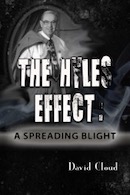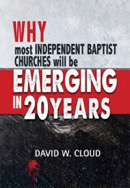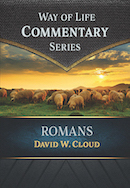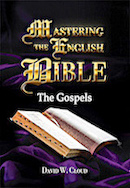866-295-4143, fbns@wayoflife.org
Another example of the bitter persecutions against Bible believers in the 16th century was the destruction of the Waldensian colony at Calabria.
a. Calabria, in southern Italy, had been settled by Waldensian Christians from Piedmont, in the Italian Alps, in the 1300s and they had flourished there unmolested for 200 years.
b. By the 16th century, the Waldensian churches in Calabria had largely grown lukewarm.
(1) Being stirred up by the bold suffering of Protestants in Switzerland and by the Waldensian churches in northern Italy, some of the Calabrian believers desired revival.
(2) In 1558, some of the Waldensian churches of Calabria sent one of their pastors, Marco Uscegli, to Geneva to seek the assistance of Swiss preachers who could instruct the saints and proclaim the gospel in their communities.
c. Jean Louis Pascal (Joannes Aloisius Pascalis) [pictured above] was chosen for this perilous mission. When he said goodbye to his betrothed bride, it is certain that they understood that they might never see each other again. The monster of persecution was raging across Europe, and no Bible believers were completely safe from its fierce jaws. Further, Rome had a special antagonism toward the Waldensians.
d. Pascal had grown up as a Roman Catholic, but the Lord had opened his eyes to the gospel of the grace of Jesus Christ. He turned his back on Romanism and threw in his lot with Protestants in Switzerland. He was a soldier by profession, but when the Lord called him to preach, he left that and studied for the ministry. He completed his courses in Lausanne in 1558 and was engaged to be married to a sweet Protestant girl named Camilla Guerina.
e. In 1558, Louis arrived in Calabria and began to preach the gospel publicly as well as to instruct the churches. We are told that his preaching was attended with much blessing from the Lord.
f. In July 1559, a charge of heresy was brought against the Calabrian Waldensian preachers, and the Catholic authority, marquis Salvator-Spinello, sent word that representatives must appear before him. Louis Pascal and Marco Ascegli obeyed, praying that their opponents could be silenced by the voice of truth and reason. That was not to be the case. When the marquis understood that the pastors would not submit their doctrine and conscience to him, he had them thrown into the vile dungeons of Foscalda. There they languished for eight months.
g. On February 7, 1560, they were transferred to the dungeons of Cosenza.
(1) There Ascegli was tortured then burned to death.
(2) Waldensian preacher Stephen Negrino, who was from Piedmont but was ministering in Calabria, was also arrested about the same time. After great torments and persistent attempts by his persecutors to get him to recant, he eventually died of starvation “or of other secret tortures” in prison at Cosenza.
(3) Another Waldensian pastor, James Bovell, who was arrested in Calabria, was taken to Messina and burned.
h. On April 14, Pascal was condemned to the galleys and, in the company of 22 other prisoners, he was forced to endure a nine-day trip, “under circumstances of great cruelty,” to Naples.
i. The pope’s inquisitor-general, Cardinal Alexandrini, had other plans for this Waldensian preacher, though, and on May 16, Pascal was taken in chains to Rome and imprisoned in the pope’s “deep, dark, damp dungeon” at Torre di Nona. (This was one of the main prisons in Rome, used especially for those who were condemned to death.) He did not have even straw to lie on, and “his arms were bound so tightly with small cords that they entered the flesh.” The cruel officers of the Inquisition attempted to convert the preacher to Romanism and engaged in argument with him for four hours each day for three days.
j. Jean’s own brother, who was a staunch Roman Catholic, visited him in prison and was greatly moved by his suffering. He begged him with tears to recant and offered him half of his property if he would disclaim the Bible doctrines that made him the enemy of Rome.
k. Pascal’s confidence in Christ was not shaken by these trials and by his impending doom, nor even by the thought that he would never see his beloved fiancée again and that she would be brought to grief. Writing to his loving but deluded brother from prison, Pascal testified: “But as for me, God has bestowed on me that knowledge of our Lord Jesus Christ which assures me that I am not in an error, and I know that I must go by the narrow way of the cross, and seal my testimony with my blood. I do not dread death, and still less the loss of my earthly goods; for I am certain of eternal life and a celestial inheritance, and my heart is united to my Lord and Saviour” (M’Crie, Reformation in Italy, p. 173).
l. On September 9, 1560, Pascal was burned in a public spectacle before the reigning pope, Pius IV and other wolves in sheep’s clothing who had assembled to devour this lamb. Wylie describes the scene, which was repeated with different scenery and different people countless times across Europe and England:
Standing upon the summit of the Janiculum Mount, vast crowds could witness the spectacle. In front the Campagna spreads out its once glorious but now desolated bosom; and winding through it like a thread of gold is seen the Tiber, while the Apennines sweeping round it in craggy grandeur enclose it like a vast wall. Immediately beneath, uprearing her domes and monuments and palaces, with an air that seems to say, "I sit a queen," is the city of Rome. Yonder, asserting an easy supremacy amid the other fabrics of the Eternal City, is the scarred and riven yet Titanic form of the Coliseum, with its stains of early Christian blood not yet washed out. By its side, the partner of its guilt and doom, lies the Palatine, once the palace of the world's master, now a low mound of ruins, with its row of melancholy cypresses, the only mourners on that site of vanished glory and fallen empire. Nearer, burning in the midday sun, is the proud cupola of St. Peter's, flanked on the one side by the buildings of the Inquisition, and on the other by the huge Mole of Hadrian, beneath whose gloomy ramparts old Tiber rolls sluggishly and sullenly along. But what shout is this which we hear? Why does Rome keep holiday? Why do all her bells ring? Lo! from every street and piazza eager crowds rush forth, and uniting in one overwhelming and surging stream, they are seen rolling across the Bridge of St. Angelo, and pressing in at the gates of the old fortress, which are thrown wide open to admit this mass of human beings.
Entering the court-yard of the old castle, an imposing sight meets the eye. What a confluence of ranks, dignities, and grandeurs! In the center is placed a chair, the emblazonry of which tells us that it claims to rise in authority and dignity over the throne of kings. The Pontiff, Pius IV, has already taken his seat upon it, for he has determined to be present at the tragedy of to-day. Behind his chair, in scarlet robes, are his cardinals and counselors, with many dignitaries besides in miters and cowls, ranged in circles, according to their place in the Papal body. Behind the ecclesiastics are seated, row on row, the nobility and beauty of Rome. Plumes wave, stars gleam, and seem to mock the frocks and cowls gathered near them, whose wearers, however, would not exchange these mystic garments for all the bravery that blazes around them. The vast sweep of the Court of St. Angelo is densely occupied. Its ample floor is covered from end to end with a closely-wedged mass of citizens, who have come to see the spectacle. In the center of the throng, rising a little way over the sea of human heads, is seen a scaffold, with an iron stake, and beside it a bundle of faggots.
A slight movement begins to be perceptible in the crowd beside the gate. Some one is entering. The next moment a storm of hissing and execration salutes the ear. It is plain that the person who has just made his entrance is the object of universal dislike. The clank of irons on the stone floor of the court, as he comes forward, tells how heavily his limbs are loaded with fetters. He is still young; but his face is pale and haggard with suffering. He lifts his eyes, and with countenance undismayed surveys the vast assembly, and the dismal apparatus that stands in the midst of it, waiting its victim. There sits a calm courage on his brow; the serene light of deep, untroubled peace beams in his eye. He mounts the scaffold, and stands beside the stake. Every eye is now turned, not on the wearer of the tiara, but on the man who is clad in the sanbenito [a robe worn by those condemned in the inquisition]” (Wylie, History of the Waldenses, pp. 119,120).
m. Addressing the crowd, Pascal proclaimed, “Good people, I am come here to die for confessing the doctrine of my Divine Master and Saviour, Jesus Christ.” The pope probably got more than he bargained for, when Pascal boldly “arraigned him as the enemy of Christ, the persecutor of his people, and the Anti-Christ of Scripture, and concluded by summoning him and all his cardinals to answer for their cruelties and murders before the throne of the Lamb” (Wylie, History of the Waldenses, c. 1860, p. 120).
n. At these words, “the people were deeply moved, and the pope and the cardinals gnashed their teeth.” The executioners strangled him, kindled the fire, and consumed his body to ashes.
o. The pope instigated unspeakable persecution against the Calabrian Waldensians. In two years, 1,600 of these harmless Christians died at the hands of their Catholic tormenters. Many had their throats slit. “Others were sawed asunder. Others, eighty-six in number, having been first flayed alive, had their bodies cleft in two, and the ghastly portions were stuck on pikes along the high road, for the length of thirty-six miles. The preachers and elders of the Waldenses were burned alive, their bodies having been covered with resin and sulpher. For two whole years did the fire and sword of antichrist devour this unhappy district, and sixteen hundred victims gratified with their blood the sanguinary thirst of Rome” (A.W. Mitchell, The Waldenses of Piedmont, 1853, pp. 85, 86).
p. Those who fled were at constant risk of being captured. “Being forced to travel only by night, very frequently to go up to the course of rivers till they could meet with fords, scantily fed on seeds, roots, fruits, and what they could get as alms, or purchase in out-of-the way places. Many of them were stopped on the road and delivered up, the order having been given throughout Italy, to all officers of police, lightermen, bargemen, and others, not to allow to pass, and to every inn-keeper, not to lodge, any stranger presenting himself without a certificate from his parish priest, attested at each stage of his journey, from the place of his setting out” (Antoine Monastier, The History of the Vaudois Church, 1849, p. 196).
q. The destruction of the Waldensians in Calabria was so complete that the area was permanently depopulated of them. Waldensian pastor Antoine Monastier, writing in 1849, testified that “at the present day, we should seek in vain, in these countries [Calabria and surrounding parts], for vestiges of the once flourishing Vaudois colonies.”
r. Those who successfully fled Calabria were scattered across other parts of Europe, carrying with them the gospel of Jesus Christ.
The above is excerpted from ROME AND THE BIBLE: TRACING THE HISTORY OF THE ROMAN CATHOLIC CHURCH AND ITS PERSECUTION OF THE BIBLE AND OF BIBLE BELIEVERS. ISBN 1-58318-003-6. To our knowledge, this is the first history ever published that documents the Roman Catholic Church’s relationship to the Bible from the first millennium to the present. It could be entitled “The Bible through the Centuries.” The author spent thousands of dollars obtaining rare documents relevant to this history for his own library (such as a 1641 edition of Foxe’s unabridged Acts and Monuments) and has researched the topic in major libraries in Canada, America, England, Ireland, and Europe. The book covers the Roman Catholic Inquisition from the 11th to the 19th centuries, the history of ancient separated Christians, including the Paulicians, Waldensians, and Lollards, the history of the English Bible from John Wycliffe to William Tyndale, the history of the Spanish, German, French, and Italian Bibles. It describes how that Rome has changed tactics since the 20th-century and joined hands with the Bible societies. The book contains 100 illustrations, mostly from rare books. When I was in Ireland in the early 1990s, Dr. Ian Paisley commended Rome and the Bible and showed us his copy in which he had written the following words: “Brother Cloud is not beclouded!” Fourth edition April 2009, 310 pages. Available in print and eBook editions from www.wayoflife.org or 866-295-4143.
- Receive these reports by email
- www.wayoflife.org
______________________
Sharing Policy: Much of our material is available for free, such as the hundreds of articles at the Way of Life web site. Other items we sell to help fund our expensive literature and foreign church planting ministries. Way of Life's content falls into two categories: sharable and non-sharable. Things that we encourage you to share include the audio sermons, O Timothy magazine, FBIS articles, and the free eVideos and free eBooks. You are welcome to make copies of these at your own expense and share them with friends and family. You may also post parts of reports and/or entire reports to websites, blogs, etc as long as you give proper credit (citation). A link to the original report is very much appreciated as the reports are frequently updated and/or expanded. Things we do not want copied and distributed are "Store" items like the Fundamental Baptist Digital Library, print editions of our books, electronic editions of the books that we sell, the videos that we sell, etc. The items have taken years to produce at enormous expense in time and money, and we use the income from sales to help fund the ministry. We trust that your Christian honesty will preserve the integrity of this policy. "For the scripture saith, Thou shalt not muzzle the ox that treadeth out the corn. And, The labourer is worthy of his reward" (1 Timothy 5:18). Questions? support@wayoflife.org
Goal:Distributed by Way of Life Literature Inc., the Fundamental Baptist Information Service is an e-mail posting for Bible-believing Christians. Established in 1974, Way of Life Literature is a fundamental Baptist preaching and publishing ministry based in Bethel Baptist Church, London, Ontario, of which Wilbert Unger is the founding Pastor. Brother Cloud lives in South Asia where he has been a church planting missionary since 1979. Our primary goal with the FBIS is to provide material to assist preachers in the edification and protection of the churches.
Offering: Offerings are welcome if you care to make one. If you have been helped and/or blessed by our material offerings can be mailed or made online with with Visa, Mastercard, Discover, or Paypal. For information see: www.wayoflife.org/about/makeanoffering.html.





